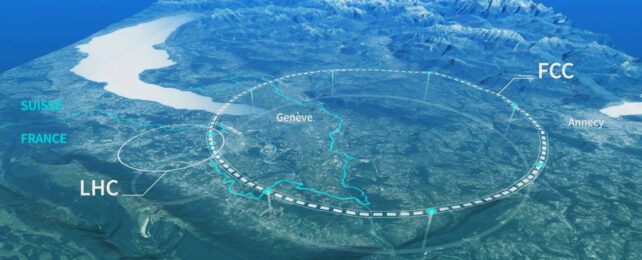ARTICLE AD
Physics13 February 2024
By Mark Thompson, Universe Today
 Future Circular Collider. (CERN)
Future Circular Collider. (CERN)
One of my favourite science and engineering facts is that an underground river was frozen to enable the Large Hadron Collider (LHC) to be built!
On its completion, it helped to complete the proverbial jigsaw of the Standard Model with is last piece, the Higgs Boson. But that's about as far as it has got with no other exciting leaps forward in uniting gravity and quantum physics.
Plans are now afoot to build a new collider that will be three times longer than the LHC and it will be capable of smashing particles together with significantly more energy.
In the past few decades, particle colliders have become a key tool for unraveling the mysteries of the universe at the fundamental level. The Large Hadron Collider (LHC), was a game changer and, with an amazing 27 kilometer (17 mile) circumference became the world's most powerful collider.
There are now plans to increase the number of collisions to try and improve its input to understanding the Universe, but even with this 'High Luminosity' phase CERN (European Council for Nuclear Research) wants to go even further and build a new collider!
If colliders like LHC are to play a part in high energy physics over the coming years then energy thresholds need to pushed beyond current capabilities. The Future Circular Collider (FCC) study has looked into various collider designs, envisaging a research infrastructure housed within a 100 kilometer underground tunnel. This ambitious project is promising a physics program that will take high energy research into the next century.
There are a number of challenges that face the design and engineering of the new tunnel however; it must steer clear of geologically interesting areas, optimise future collider efficiency, allow for connectivity with the LHC, and adhere to social and environmental impacts of the surface buildings and infrastructure.
Choosing 'where to put it' seems to be quite the challenge so a range of layout options are being considered, guided by CERN's intent to avoid the impact on the area.
Within the FCC tunnel (which looks like it will be placed beneath ring-shaped underground tunnel located beneath Haute-Savoie and Ain in France and Geneva in Switzerland) will be two colliders that will work together sequentially.
The first phase is scheduled for inauguration around mid-2040s and comprises an electron-positron collider (FCC-ee). The hope is that it will give unparalleled precision measurements and unveil physics beyond the standard model. Following hot on its heels will be the proton-proton collider (FCC-hh) which will surpass the energy capability of LHC eightfold!
It's an exciting prospect that FCC will push particle collision to energies of 100 TeV in the hope of uncovering new realms of physics. To achieve the goal however, new technological advances will be required and to that end, over 150 universities from around the world are exploring the options.
This article was originally published by Universe Today. Read the original article.

 1 year ago
69
1 year ago
69 

